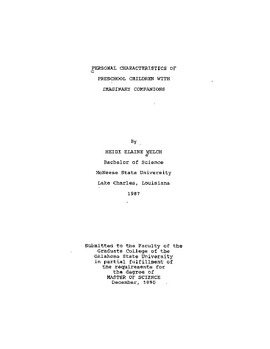| dc.description.abstract | The purpose of this study was to determine personal characteristics of 3, 4, and 5 year old preschool children with imaginary companions. Preschool children 3, 4, and 5 years old were interviewed in order to identify preschool children with imaginary companions as well as to obtain descriptive information about make-believe friends. The final sample consisted of 42 preschool children enrolled in either a university laboratory school or a private preschool. Twenty-one children reported an imaginary character (12 females and 9 males, with an age range of 46 to 65 ,months). These children were matched with 21 children who reported no imaginary,companions (12 females and 9 males, with an age range of 44 to 65 months). The Multidimensional Stimulus Fluency Measure was used to identify creative potential in the preschool children. The Kohn Social Competence Scale, a teacher rating, was used to assess the social and emotional functioning of the preschoolers. Mothers completed the Behavioral style Questionnaire, an assessment of the child's temperament. Results from the probit analyses revealed that five single independent variables (originality, interest-participation, cooperation-compliance, approach, and adaptability scores) did not significantly predict the presence of imaginary companions. However, children with imaginary companions scored significantly higher on the intensity dimension of the temperament scale than children without pretend friends. When the three temperament variables (intensity, approach, adaptability) were examined together within a model, results demonstrated that these temperament variables significantly predicted the presence of imagin-ary companions. Individual differences in temperament appear to be important characteristics in looking at pre-school children with makebelieve friends. Also, children with imaginary companions - ' scored significantly higher on the social competence scale than children without imaginary companions. Children with greater social skills may practice and rehearse their social interactions with imaginary companions. | |
